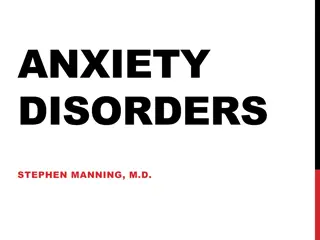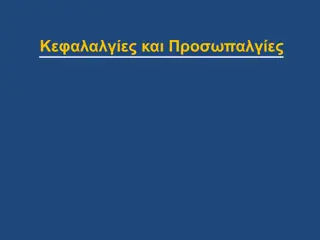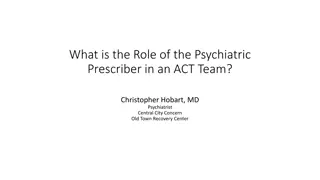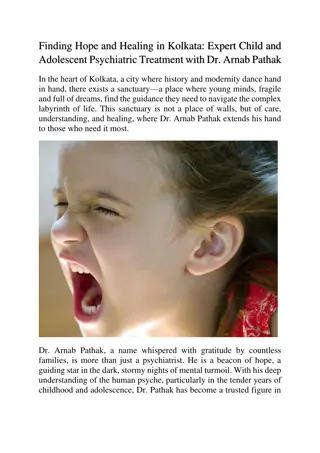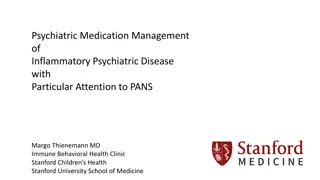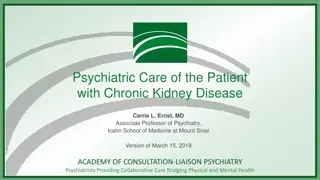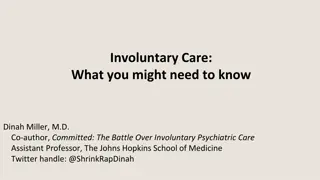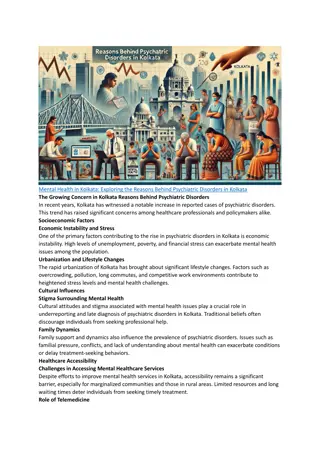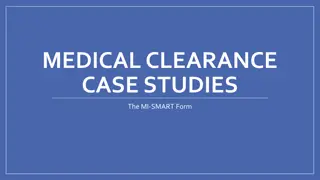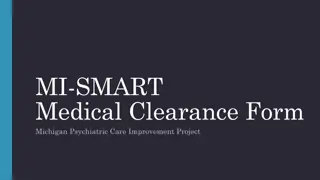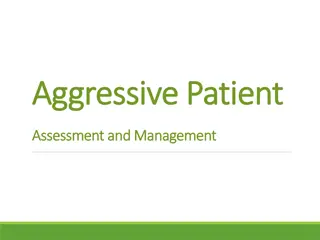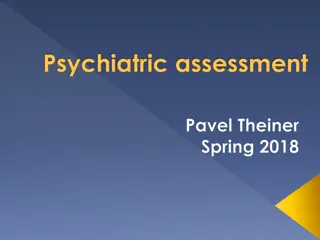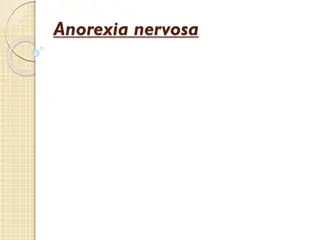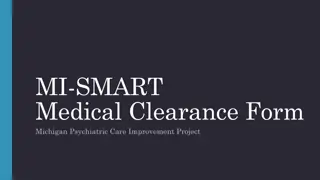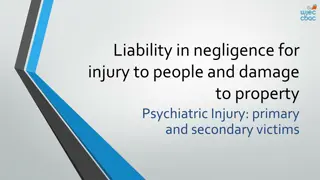Overview of Classification of Psychiatric Disorders
Psychiatric disorders are illnesses with various manifestations that impact functioning due to disturbances in biological, social, genetic, and other factors. Two key classification systems, ICD-10 and DSM-5, categorize over 200 types of psychiatric illnesses. The ICD-10 includes categories like organic disorders, substance use-related disorders, schizophrenia, mood disorders, and more. The DSM series by the APA has evolved over the years, with DSM-IV featuring a multiaxial system to assess patients across five axes covering clinical diagnosis, personality disorders, medical conditions, psychosocial issues, and global assessment of functioning.
Download Presentation

Please find below an Image/Link to download the presentation.
The content on the website is provided AS IS for your information and personal use only. It may not be sold, licensed, or shared on other websites without obtaining consent from the author. Download presentation by click this link. If you encounter any issues during the download, it is possible that the publisher has removed the file from their server.
E N D
Presentation Transcript
1 CLASSIFICATION OF PSYCHIATRIC DISORDERS
Mental Disorder/Psychiatric Disorder 2 Is an illness with psychogenic or behavioral manifestations associated with impairment in functioning due to biologic, social, psychogenic, genetic, physical and chemical disturbances.
3 Two main Classification Systems ICD 10 (International Classification of Diseases) of WHO DSM 5 (Diagnostic and Statistical Manual) of APA Over 200 types of psychiatric illness are classified and according to ICD 10 the main categories of illness or disorders are-
Categories of ICD 10 1. Organic including symptomatic, mental disorders 2. Mental and behavioral disorders due to psychoactive substance use. 3. Schizophrenia, Schizotypal and Delusional disorder. 4. Mood (Affective) disorders 5. Neurotic, Stress related and Somatoform disorder. 4
5 6. Behavioral syndromes associated with physiological disturbance and physical factors 7. Disorders of adult personality and behaviour 8. Mental retardation 9. Disorders of psychological development 10.Behavioral and emotional disorders with onset usually occurring in childhood or adolescences.
The DSM classification. 6 In 1952, the APA published the DSM I. DSM-II (1968); DSM-III (1980); DSM-III-R (1987); DSM-IV (1994); and DSM-IV-TR (2000). DSM - 5 Research started in 1999. Released in May 2013.
7 DSM IV (Diagnostic & Statistical Manual) 1994 :- This is the classification of mental disorders by the American Psychiatric Association (APA). The pattern adopted by DSM IV is of Multiaxial systems. A multiaxial system that evaluates patients along several versatile contains Five axes. Axis I & II make up the entire classification which contains more than 300 specific disorders.
The Five Axes of DSM IV Are:- 8 Axis I : Clinical psychiatric diagnosis Axis II : Personality disorder & mental retardation Axis III : General medical conditions Axis IV : Psychosocial & environmental problems Axis V : Global assessment of functioning in current & past one year.
9 DSM 5 (Diagnostic and Statistical Manual) Diagnostic Criteria 1. Neurodevelopmental disorders Intellectual Dis., Autism spectrum, ADHD 2. Schizophrenia spectrum and other psychotic disorders 3. Bipolar and related disorders 4. Depressive disorders
5. Anxiety disorders 6. Obsessive-compulsive and related disorders 7. Trauma- and stressor-related disorders 8. Dissociative disorders 9. Somatic symptom and related disorders 10.Feeding and eating disorders 10 11.Elimination disorders 12.Sleep-walk disorders 13.Sexual dysfunctions
14.Gender dysphoria 11 15.Disruptive, impulse-control, and conduct disorders 16.Substance-related and addictive disorders 17.Neurocognitive disorders 18.Personality disorders 19.Paraphilic disorders 20.Other mental disorders
Indian Classification:- 12 In India Neki (1963), Wig & Singer (1967), Vahia (1961) & Varma (1971) have attempted some modification of ICD 8 to suit Indian conditions. A)Psychosis:- 1. Functional:- Schizophrenia 2. Affective:- Mania & Depression 3. Organic:- Acute or Chronic
COUNT B) Neuroses:- Anxiety neurosis Depressive neurosis Hysterical neurosis Obsessive- compulsive neurosis Phobic neurosis C) Special disorders: Childhood disorders Personality disorders Substances abuses Psycho physiological disorders Mental retardation 13
Difference between Psychosis and Neurosis 15 PSYCHOSIS NEUROSIS I. Etiology i. Genetic factorsMore important (in Less important disorders like (important in schizophrenia, mood making a personality disorders etc.) Less important vulnerable) More important ii. Stressful life events II. Psychopathology Personality disintegration Total Partial
16 III. Clinical Features i. Touch with reality Lost Not ii. Insight into the illness Lost (Patient usually brought by the relatives). Impaired Present (Patient himself comes for treatment). Intact iii. Judgment iv. Social relationships and behavior v. Neglect of Personal hygiene Markedly affected Usually not affected May be present Not vi. Disturbances of memory, orientation, consciousness and intelligence vii. Disturbances of thinking (delusions) and Perception (illusions and hallucinations) Common (in organic psychoses) Rare Common Rare
17 IV. TREATMENT i. Electroconvulsive Very useful (in Not useful therapy (ECT) Functional Psychoses) ii. Drugs Neuroleptics Minor tranquillizers (Major tranquillizers and antidepressants And anti- depressants commonly used) commonly used iii. Psychotherapy Supportive type Analytic, supportive (useful and other types very When the patient is in useful. remission)
18 V. Prognosis Difficult to treat. Easy to treat. Recovery may not Recovery is be possible. possible and Relapses are complete. Relapses common are uncommon



